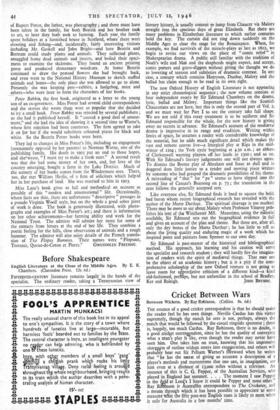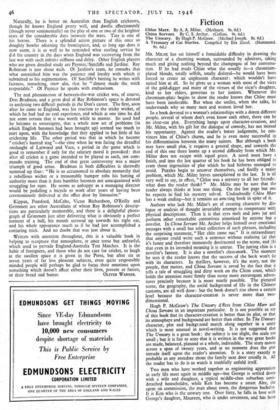Cricket Between Wars
Between Wickets. By Ray Robinson. (Collins. 8s. 6d.)
THE essence of a good cricket correspondent is that he should make the reader feel he has seen things. Neville Cardus has this virtue supremely, though the match he sees is not, perhaps, always the match that would be followed by the casual ringside spectator ; there is, happily, too much Cardus. Ray Robinson, there is no doubt, 13 a good cricket correszondent, since he has the quality of conveyin; what a Man's play Is "like, even though the reader may never have seen him. One takes him on trust, knowing that his impressive sharpass of outline seldom strays into exaggeration, and others will probably bear out Sir Pelham Warner's ftSfeword when he writes that "he has the secret of giving so accurate a description of a player's methods and mannerisms that one can, in imagination, set him even at a distance of 13,000 miles without a televisor. An instance of this is C. G. Pepper, of the Australian Services, who played in England last summer. . . . The moment I saw Pepper in the at Lori's I knew it could be Pepper and none other." Ray R on is AustrallAn correspondent to The Cricketer, and a means through which it has been possible to appreciate to some measure what the fifst post-war t nglish team is likely to meet when it sails for Australia in a few months' time.
Naturally, he is better on Australian than English cricketers, though he knows England pretty well, and dwells affectionately (though never sentimentally) on the play of one or two of the brighter stars of the considerable days between the wars. Tate is one of his heroes. There is a splendid action picture of this once so doughty bowler adorning the frontispiece, and, so long ago does it now seem, it is as well to be reminded what sterling service he dd his country in the days when England- was recovering from the last war with such infinite stiffness and delay. Other English players who are given detailed study arc Paynter,7Sutcliffe and Jardine. Ray Robinson is just about each. Of Jardine's team, he remarks that what astonished him was the patience and loyalty with which it submitted to his regimentation. Of Sutcliffe's batting he writes with fairness, remarking, inter alia, that he " almost made the snick respectable." Of Paynter he speaks with enthusiasm.
The real phenomenon of between-the-war cricket was, of course, Don Bradman, and a great deal of Ray Robinson's space is devoted to analysing two difficult periods in the Don's career. The first, soon after he came to England, was his reaction to the sticky wicket, of which he had had no real experience, and which at one time he did not seem certain that it was worth while to master. So used had he become to sovereignty, that a whole new set of problems (in which English batsmen had been brought up) seemed too much to start upon, with the knowledge that they applied to but little of his cricketing life. The other period was that in which he became "cricket's hunted stag "—the time when he was facing the dreadful onslaught of Larwood and Voce, a period in the game which is good to remember if only for the salutary moral it provoked: that after all cricket is a game intended to be played as such, not com- mando training. The end of that great controversy was a major triumph of good sense. Bradman in both difficulties is shrewdly summed up thus : " He is so accustomed to absolute monarchy that a rebellious wicket or a treasonable bumper robs his batting of authority more than it does humbler batsmen not unacquainted with struggling for rims. He seems as unhappy as a managing director would be pedalling a bicycle to work after years of having been ceremoniously delivered at the office door by limousine."
Kippax, Ponsford, McCabe, Victor Richardson, O'Reilly and Grimmett are other Australians of whom Ray Robinson's descrip- - tions are particularly- memorable, and there is a delightful photo- graph of Grimmett just after delivering what is obviously a perfect torment of a ball, his mouth screwed up towards his right ear, and his whole appearance much as if he had -just accomplished a conjuring trick. And no doubt that was just about it.
Written with attention throughout, this is a valuable book in helping to recapture that atmosphere, at once tense but unfearful, which used to pervade England-Australia Test Matches. It is the habit of foreigners, and those who do not care for cricket, to laugh at the swollen space it is given in the Press, but after six or seven years of far less pleasant subjects, even quite responsibly minded people will perhaps be glad to focus -their emotions upon something which doesn't affect either their lives, present or future,































 Previous page
Previous page